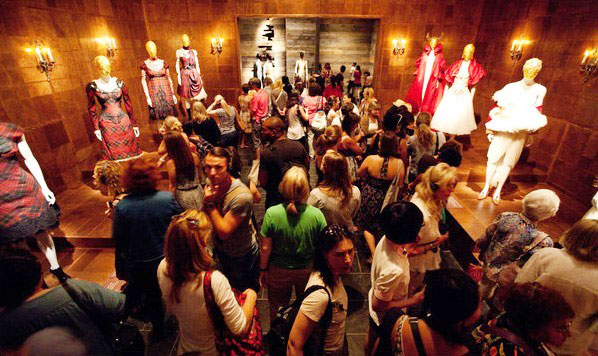At the met, McQueen's final showstopper
Updated: 2011-08-02 15:14
(The New York Times)
|
|||||||||||
 |
|
[Photo/The New York Times] |
There was a reason Alexander McQueen, who committed suicide last year at the age of 40, was considered one of the greatest fashion designers of his generation, admired by his peers for his astounding technical ability and idolized by students for his near-fearless risk taking. "People don't want to see clothes," he once said. "They want to see something that fuels the imagination."
But while he was revered in fashion, and his runway shows were among the most closely watched, almost no one could have imagined that, as the subject of a museum exhibition, Mr. McQueen would prove to be almost as popular as Pablo Picasso and Vincent van Gogh.
At some point this weekend or thereabouts, and with still a week to go in its three-month run, the wildly popular McQueen retrospective at the Metropolitan Museum of Art, based on its current trajectory, will set an attendance record for a fashion exhibition there when it surpasses the 576,000 visitors for "Superheroes: Fashion and Fantasy" in 2008. By the time it closes on Aug. 7, in all likelihood it will rank among the museum's 20 most popular exhibitions since it began tracking attendance 50 years ago.
Since the exhibition opened in May, its galleries have been mobbed with hundreds of guests at a time, from morning until night, with sometimes hours-long lines waiting behind ropes, framed by famous works of Gustave Moreau, Auguste Rodin and Henri Regnault.
Its duration has been extended at least twice and, for the last two nights, Aug. 6 and 7, the museum has announced it will stay open until midnight, the first time the Met has kept an exhibition open so late. As of Friday morning, 553,000 people had seen the show, including quite a few who would have professed that they cared not a thing about fashion.
"You take a medium like fashion that you don't think is going to have that much depth, and then you find that it does," said Edward Murguia, 67, a sociology professor at Texas A&M University, as he exited the show on a recent afternoon. His wife had dragged him along, he said. "You can just see people walk by saying, this is great art, and they are fascinated by this," he said. "I could never imagine how much he got done in such a short life. It's just amazing to look at the level of detail."
The degree to which "Alexander McQueen: Savage Beauty" has ignited wide-scale public interest would have been a remarkable achievement for any exhibition dedicated to the work of a single artist. But the fact that it was one whose chosen medium was fashion design makes it a phenomenal achievement, surpassing the expectations of museum officials and perhaps defying them in an institution where, until recent years, costume shows had historically been confined to its basement.
How this success happened is not so easily explained, not even by the growing importance of Mr. McQueen during his short career. You might have heard his name because of the circumstances of his death or, in April, because of the wedding gown created for Catherine, Duchess of Cambridge, by Sarah Burton of the studio that survives him.
Or you might have heard of him well before that, as the British provocateur who frequently thumbed his nose at the royal family, who once created pants that were cut so low that they were nicknamed the bumster, who had problems with drug and drink, and who fearlessly, and often brilliantly, presented collections of wonderfully imaginative clothes for which models were cast as inmates in an insane asylum, pieces of a chess set or victims of extreme plastic surgery.
And yet, helping to explain the long lines and claustrophobia-inducing crowds at the Met, you might not have had a very clear picture of who Mr. McQueen was, as a designer and as a person, and quite arguably as an artist, had you not seen this show.
"It really is an emotional connection, and I think that has to be the key to it all," said Trino Verkade, the longtime creative coordinator of Mr. McQueen's studio, who has spent countless hours in the galleries this summer, watching people as they react to his designs. "Everybody feels emotions," she said. "They can easily recognize them in Lee's work," referring to the designer by the name his close friends called him, "and they have identified with those emotions as they walk through."